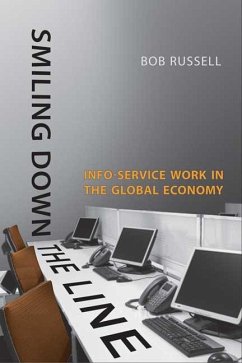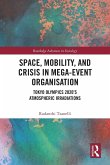- Broschiertes Buch
- Merkliste
- Auf die Merkliste
- Bewerten Bewerten
- Teilen
- Produkt teilen
- Produkterinnerung
- Produkterinnerung
Smiling Down the Line theorizes call centre work as info-service employment and looks at the effects of ever-changing technologies on service work, its associated skills, and the ways in which it is managed.
Andere Kunden interessierten sich auch für
![Surviving the International War Zone Surviving the International War Zone]() Robert R RailSurviving the International War Zone83,99 €
Robert R RailSurviving the International War Zone83,99 €![Gender Equality and the Media Gender Equality and the Media]() Gender Equality and the Media57,99 €
Gender Equality and the Media57,99 €![Information System Audit Information System Audit]() Philippe PeretInformation System Audit63,99 €
Philippe PeretInformation System Audit63,99 €![The Global Horseracing Industry The Global Horseracing Industry]() Phil McmanusThe Global Horseracing Industry73,99 €
Phil McmanusThe Global Horseracing Industry73,99 €![Space, Mobility, and Crisis in Mega-Event Organisation Space, Mobility, and Crisis in Mega-Event Organisation]() Rodanthi TzanelliSpace, Mobility, and Crisis in Mega-Event Organisation59,99 €
Rodanthi TzanelliSpace, Mobility, and Crisis in Mega-Event Organisation59,99 €![The Serious Leisure Perspective The Serious Leisure Perspective]() Sam ElkingtonThe Serious Leisure Perspective63,99 €
Sam ElkingtonThe Serious Leisure Perspective63,99 €![The American Way of Death Revisited The American Way of Death Revisited]() Jessica MitfordThe American Way of Death Revisited14,99 €
Jessica MitfordThe American Way of Death Revisited14,99 €-
-
-
Smiling Down the Line theorizes call centre work as info-service employment and looks at the effects of ever-changing technologies on service work, its associated skills, and the ways in which it is managed.
Hinweis: Dieser Artikel kann nur an eine deutsche Lieferadresse ausgeliefert werden.
Hinweis: Dieser Artikel kann nur an eine deutsche Lieferadresse ausgeliefert werden.
Produktdetails
- Produktdetails
- Verlag: University of Toronto Press
- Seitenzahl: 352
- Erscheinungstermin: 1. September 2009
- Englisch
- Abmessung: 226mm x 150mm x 23mm
- Gewicht: 522g
- ISBN-13: 9781442609815
- ISBN-10: 1442609818
- Artikelnr.: 26834396
- Herstellerkennzeichnung
- Libri GmbH
- Europaallee 1
- 36244 Bad Hersfeld
- gpsr@libri.de
- Verlag: University of Toronto Press
- Seitenzahl: 352
- Erscheinungstermin: 1. September 2009
- Englisch
- Abmessung: 226mm x 150mm x 23mm
- Gewicht: 522g
- ISBN-13: 9781442609815
- ISBN-10: 1442609818
- Artikelnr.: 26834396
- Herstellerkennzeichnung
- Libri GmbH
- Europaallee 1
- 36244 Bad Hersfeld
- gpsr@libri.de
Bob Russell is an associate professor in the Department of Employment Relations at Griffith Business School, Griffith University.
List of Tables and Figures
List of Abbreviations
Acknowledgments
1. New Workplaces: The Call Centre
1.1 Introduction
1.2 The Three Changes
1.2.1 ICTs and the Technical Division of Labour
1.2.2 Globalization and the Social Division of Labour
1.2.3 Beyond Consent? Managerialism and Human Resource Management
1.3 The Rest of the Book
2. The Call-Centre Case Studies
2.1 Studying Call Centres: Methodological Matters
2.2 The Centres
2.3 Summary
3. Making a New Occupation
3.1 Introduction
3.2 The Recruitment and Selection of Call Centre Labour
3.3 Employment Status
3.4 Training
3.5 'Shall I Stay or Shall I Go?': Attrition and Retention in Call Centres
4. The Call-Centre Labour Process (1): The Division of Labour, Work Effort,
and Job Skill
4.1 Introduction
4.2 Experiencing the Labour Process: Work Intensity and the Effort Bargain
4.3 Call Centres and Job Skills
4.4 Emotional Labour in Call Centres
4.5 Conclusions
5. The Call-Centre Labour Process (2): Technological Selection and the
Means of Communication in Info-Service Work
5.1 Introduction
5.2 Theoretical Issues
5.3.1 The Case Study: What Did Management Want?
5.3.2 Between the Cup and the Lip: The Adoption of CMS
5.4 Conclusions
6. HRM and Call Centres: Culture and Identities
6.1 Introduction
6.2 HRM in Call Centres
6.3 Identity in the Call Centre
6.4 Accounting for Organizational Identities
6.5 Conclusions
7. Globalizing Info-Service Work: Outsourcing to India (with Mohan Thite)
7.1 Introduction
7.2 The BPO Case Studies
7.3 Skills and the Global Division of Labour
7.4 Work Intensity
7.5 HRM and Identity in BPO
7.6 The Contradictions of BPO
7.7 Conclusions
8. Discontent, Resistance, and Organizing in Info-Service Work
8.1 Introduction: Work Relations in Call Centres
8.2 From Partners to Pariahs: Unions in Australian Employment
8.3 From Resistance to Organizing, or Organizing as Resistance: Unions in
Call Centres
8.4 Unionization in the Australian Case-Study Sites
8.5 A Postscript from Australia: Work Choices and Beyond
8.6 A Note on Resistance and Organization in Indian BPOs
9. Concluding Remarks
Notes
References
Index
List of Abbreviations
Acknowledgments
1. New Workplaces: The Call Centre
1.1 Introduction
1.2 The Three Changes
1.2.1 ICTs and the Technical Division of Labour
1.2.2 Globalization and the Social Division of Labour
1.2.3 Beyond Consent? Managerialism and Human Resource Management
1.3 The Rest of the Book
2. The Call-Centre Case Studies
2.1 Studying Call Centres: Methodological Matters
2.2 The Centres
2.3 Summary
3. Making a New Occupation
3.1 Introduction
3.2 The Recruitment and Selection of Call Centre Labour
3.3 Employment Status
3.4 Training
3.5 'Shall I Stay or Shall I Go?': Attrition and Retention in Call Centres
4. The Call-Centre Labour Process (1): The Division of Labour, Work Effort,
and Job Skill
4.1 Introduction
4.2 Experiencing the Labour Process: Work Intensity and the Effort Bargain
4.3 Call Centres and Job Skills
4.4 Emotional Labour in Call Centres
4.5 Conclusions
5. The Call-Centre Labour Process (2): Technological Selection and the
Means of Communication in Info-Service Work
5.1 Introduction
5.2 Theoretical Issues
5.3.1 The Case Study: What Did Management Want?
5.3.2 Between the Cup and the Lip: The Adoption of CMS
5.4 Conclusions
6. HRM and Call Centres: Culture and Identities
6.1 Introduction
6.2 HRM in Call Centres
6.3 Identity in the Call Centre
6.4 Accounting for Organizational Identities
6.5 Conclusions
7. Globalizing Info-Service Work: Outsourcing to India (with Mohan Thite)
7.1 Introduction
7.2 The BPO Case Studies
7.3 Skills and the Global Division of Labour
7.4 Work Intensity
7.5 HRM and Identity in BPO
7.6 The Contradictions of BPO
7.7 Conclusions
8. Discontent, Resistance, and Organizing in Info-Service Work
8.1 Introduction: Work Relations in Call Centres
8.2 From Partners to Pariahs: Unions in Australian Employment
8.3 From Resistance to Organizing, or Organizing as Resistance: Unions in
Call Centres
8.4 Unionization in the Australian Case-Study Sites
8.5 A Postscript from Australia: Work Choices and Beyond
8.6 A Note on Resistance and Organization in Indian BPOs
9. Concluding Remarks
Notes
References
Index
List of Tables and Figures
List of Abbreviations
Acknowledgments
1. New Workplaces: The Call Centre
1.1 Introduction
1.2 The Three Changes
1.2.1 ICTs and the Technical Division of Labour
1.2.2 Globalization and the Social Division of Labour
1.2.3 Beyond Consent? Managerialism and Human Resource Management
1.3 The Rest of the Book
2. The Call-Centre Case Studies
2.1 Studying Call Centres: Methodological Matters
2.2 The Centres
2.3 Summary
3. Making a New Occupation
3.1 Introduction
3.2 The Recruitment and Selection of Call Centre Labour
3.3 Employment Status
3.4 Training
3.5 'Shall I Stay or Shall I Go?': Attrition and Retention in Call Centres
4. The Call-Centre Labour Process (1): The Division of Labour, Work Effort,
and Job Skill
4.1 Introduction
4.2 Experiencing the Labour Process: Work Intensity and the Effort Bargain
4.3 Call Centres and Job Skills
4.4 Emotional Labour in Call Centres
4.5 Conclusions
5. The Call-Centre Labour Process (2): Technological Selection and the
Means of Communication in Info-Service Work
5.1 Introduction
5.2 Theoretical Issues
5.3.1 The Case Study: What Did Management Want?
5.3.2 Between the Cup and the Lip: The Adoption of CMS
5.4 Conclusions
6. HRM and Call Centres: Culture and Identities
6.1 Introduction
6.2 HRM in Call Centres
6.3 Identity in the Call Centre
6.4 Accounting for Organizational Identities
6.5 Conclusions
7. Globalizing Info-Service Work: Outsourcing to India (with Mohan Thite)
7.1 Introduction
7.2 The BPO Case Studies
7.3 Skills and the Global Division of Labour
7.4 Work Intensity
7.5 HRM and Identity in BPO
7.6 The Contradictions of BPO
7.7 Conclusions
8. Discontent, Resistance, and Organizing in Info-Service Work
8.1 Introduction: Work Relations in Call Centres
8.2 From Partners to Pariahs: Unions in Australian Employment
8.3 From Resistance to Organizing, or Organizing as Resistance: Unions in
Call Centres
8.4 Unionization in the Australian Case-Study Sites
8.5 A Postscript from Australia: Work Choices and Beyond
8.6 A Note on Resistance and Organization in Indian BPOs
9. Concluding Remarks
Notes
References
Index
List of Abbreviations
Acknowledgments
1. New Workplaces: The Call Centre
1.1 Introduction
1.2 The Three Changes
1.2.1 ICTs and the Technical Division of Labour
1.2.2 Globalization and the Social Division of Labour
1.2.3 Beyond Consent? Managerialism and Human Resource Management
1.3 The Rest of the Book
2. The Call-Centre Case Studies
2.1 Studying Call Centres: Methodological Matters
2.2 The Centres
2.3 Summary
3. Making a New Occupation
3.1 Introduction
3.2 The Recruitment and Selection of Call Centre Labour
3.3 Employment Status
3.4 Training
3.5 'Shall I Stay or Shall I Go?': Attrition and Retention in Call Centres
4. The Call-Centre Labour Process (1): The Division of Labour, Work Effort,
and Job Skill
4.1 Introduction
4.2 Experiencing the Labour Process: Work Intensity and the Effort Bargain
4.3 Call Centres and Job Skills
4.4 Emotional Labour in Call Centres
4.5 Conclusions
5. The Call-Centre Labour Process (2): Technological Selection and the
Means of Communication in Info-Service Work
5.1 Introduction
5.2 Theoretical Issues
5.3.1 The Case Study: What Did Management Want?
5.3.2 Between the Cup and the Lip: The Adoption of CMS
5.4 Conclusions
6. HRM and Call Centres: Culture and Identities
6.1 Introduction
6.2 HRM in Call Centres
6.3 Identity in the Call Centre
6.4 Accounting for Organizational Identities
6.5 Conclusions
7. Globalizing Info-Service Work: Outsourcing to India (with Mohan Thite)
7.1 Introduction
7.2 The BPO Case Studies
7.3 Skills and the Global Division of Labour
7.4 Work Intensity
7.5 HRM and Identity in BPO
7.6 The Contradictions of BPO
7.7 Conclusions
8. Discontent, Resistance, and Organizing in Info-Service Work
8.1 Introduction: Work Relations in Call Centres
8.2 From Partners to Pariahs: Unions in Australian Employment
8.3 From Resistance to Organizing, or Organizing as Resistance: Unions in
Call Centres
8.4 Unionization in the Australian Case-Study Sites
8.5 A Postscript from Australia: Work Choices and Beyond
8.6 A Note on Resistance and Organization in Indian BPOs
9. Concluding Remarks
Notes
References
Index








